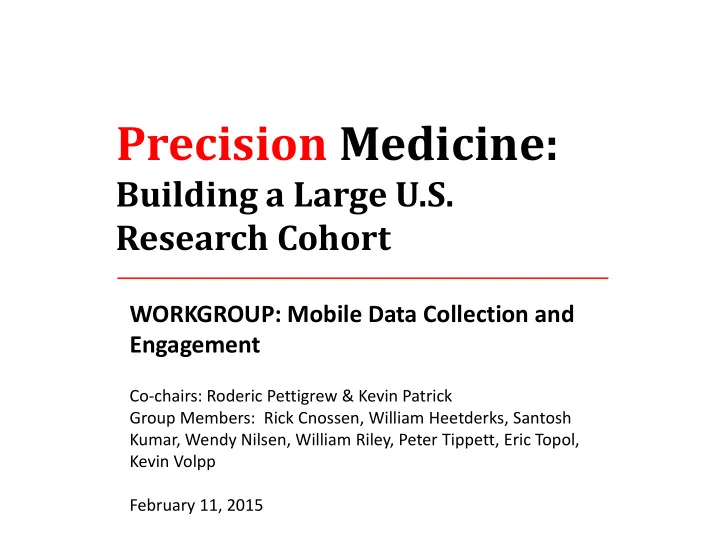

Precision Medicine: Building a Large U.S. Research Cohort WORKGROUP: Mobile Data Collection and Engagement Co ‐ chairs: Roderic Pettigrew & Kevin Patrick Group Members: Rick Cnossen, William Heetderks, Santosh Kumar, Wendy Nilsen, William Riley, Peter Tippett, Eric Topol, Kevin Volpp February 11, 2015
Current Landscape • World Gone Mobile – Pervasive – Rapidly advancing – Inter ‐ networked computing and communications environment – Extreme power at both the user and cloud level – Highly customizable – Simple user interfaces and interactions – Combined with secure communications enables novel opportunities for engagement and extensive longitudinal data collection. – Result is: • Entirely New Type of Science • Dramatically Lower Measurement Costs and Participant Burden • Automated Engagement and Support for Participants
Current Landscape 2010 2015 2020 World Population, billion 6.8 7.2 7.6 No. connected Devices, billion 12.5 25 50 Devices, per person 1.8 3.5 6.6 No. of smartphone 0.5 3.0 6.1 subscriptions, billion No. of wireless hotspots, 3.0 47 500 millions No. of transistors, 16/40 19/16 22/8 millions/chip, nm No. of sensors 20 10 1 million billion trillion No. of individuals <10 400000 5 sequenced million From Topol et al, JAMA 2015
Challenges • Traditional longitudinal assessment is expensive, burdensome and often based on inaccurate self ‐ report and periodic measures – Vitals and disease specific monitoring (e.g., ECG, blood pressure, spirometry, etc.) – Patient reported outcomes (in real ‐ time and context) – Medication adherence – Cognitive function – Physical activity; sleep – Geolocation – Social Interactions – Diet – Smoking and secondhand smoke exposure • Engaging participants in cohort studies is labor intensive & loss to follow ‐ up is common – People move over time and can fall off the map – Infrequent contact can lead to disinterest
Mobile Possibilities GPS EEG Pulmonary SpO 2 Function • Population Statistics • Epidemiology Posture ECG • Evidence • Inference Blood Gait • Data ‐ mining Pressure Step Balance Height Step Size 5 Illustration From Wactlar et al., 2011
Challenge [1]: Proposed Solution • By providing a smart phone and sensor devices : – Longitudinal passive assessment: • Physiological parameters • Physical activity; Sleep • Geolocation • Social interactions • Stress • Smoking – Longitudinal active assessment of: • Medication adherence • Patient reported outcomes • Audio and video sampling of target questions via mobile media
Challenge [2]: Proposed Solution • Using disease ‐ specific devices in sub ‐ groups : – Longitudinal Assessment: • Glucose (glucometer, but could be CGM and pump data for those who have them) • Heart function (e.g., ECG, pacemaker data for those that have them) • Blood pressure via Pressure Cuff • Lung Function via Spirometry • Weight; Temperature – Incorporate emerging sensor technologies as they become available e.g., tattoo or subcutaneous and gum ‐ based nested nanosensors to monitor biological activity (Jeong et al., Adv Healthc Mater 2014, 3 (5):642 ‐ 8).
Challenge [3]: Proposed Solution Mobile Data Systems Use : • Establish dedicated effort within Precision Medicine initiative • Leverage the current research in this area (HCI, UX, UI, user ‐ centered design) • Share best practices • Cohort Research Staff Attuned to Digital Needs • Research support staff work from the same protocols, policies and procedures manuals and technical assistance guidelines. – Goal is combination of Apple Genius Bar & optimal tech support • Develop user ‐ friendly protocols (e.g., Kindle for older adults).
Challenge [4]: Proposed Solution • Through the use of digital device data correlated with other cohort data, the initiative can: – Generate more precise and longitudinally characterized behavioral phenotypes and endophenotypes – Assess gene ‐ environment interactions on treatment and health – Better characterize treatment, adherence to treatment – Improved assessment of immediate and long range outcomes – Provide a platform for rapid testing of interventions to improve health
Challenge [5]: Additional Challenges • Standards for sensor data • Privacy, security and verification • Support individual motivation with social, financial and personalized incentives for consistent participation • Sociocultural acceptance to inform research • Data quality in the wild • Ease of use for people with varied technology backgrounds, socioeconomic and educational factors, and medical conditions. • Sufficient connectivity and bandwidth must be available • Measuring exposures to environmental factors is nascent • Technical interface of sensors with varied digital platforms • Rapid proliferation of new technologies • Ownership of the data
Audacious Ideas • Recruit volunteers to open up all of their data – genome, microbiome, medical/EMR, behavioral, social, precise geospatial (via addresses & GPS data) – so that multiple influences between and among these can be understood • Develop new culture of motivated participatory research: Promote competitions between communities across the US to become “Framingham 2.0”. Major influences on health
Recommend
More recommend